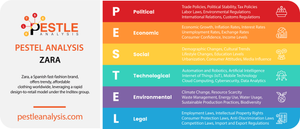My PESTLE analysis of Zara studies the external Political, Economic, Sociocultural, Technological, Legal, and Environmental factors affecting the fashion brand.
Zara is one of the hottest fast-fashion brands in the world. Founded in Spain and now with more than ten thousand stores worldwide, Zara's story is an exciting one. The question is, is this decades-old brand here to stay?
In this PESTLE analysis, I review Zara's current market standings through Political, Economic, Sociocultural, Technological, Legal, and Environmental lenses. As you'll see in a second, Zara's future certainly isn't too bad.
Imagine you’re a fashion designer with a magical wardrobe filled with six enchanted outfits, each giving you special insights into the world outside your design studio. This wardrobe is your PESTLE analysis!
- The Political outfit keeps you stylishly aware of government rules and trade policies, helping you decide where to showcase your next runway collection without being caught off guard by political turmoil.
- The Economic ensemble lets you understand consumer spending habits and economic trends so you can unleash luxury lines when people are splurging or offer budget-friendly fashion when they’re saving.
- The Social suit keeps you in tune with the latest trends and demographic changes, allowing you to design clothes that resonate with your audience, whether it’s eco-friendly fabrics for the green crowd or bold prints for the youth.
- The Technological threads ensure your brand stays cutting-edge with the latest in fashion technology, from virtual fitting rooms to AI-driven design tools.
- The Legal look ensures compliance with all laws and regulations, from labor rights to copyrighting unique designs, avoiding legal missteps.
- Lastly, the Environmental ensemble helps you adopt sustainable practices, using eco-friendly materials and reducing your carbon footprint, keeping you in vogue with environmentally conscious consumers.
With PESTLE analysis, you’re not just a designer but a fashion detective, trend forecaster, and market strategist all rolled into one, ensuring your brand is always runway-ready.
Let's start with the political outfit!
Zara's Political Factors
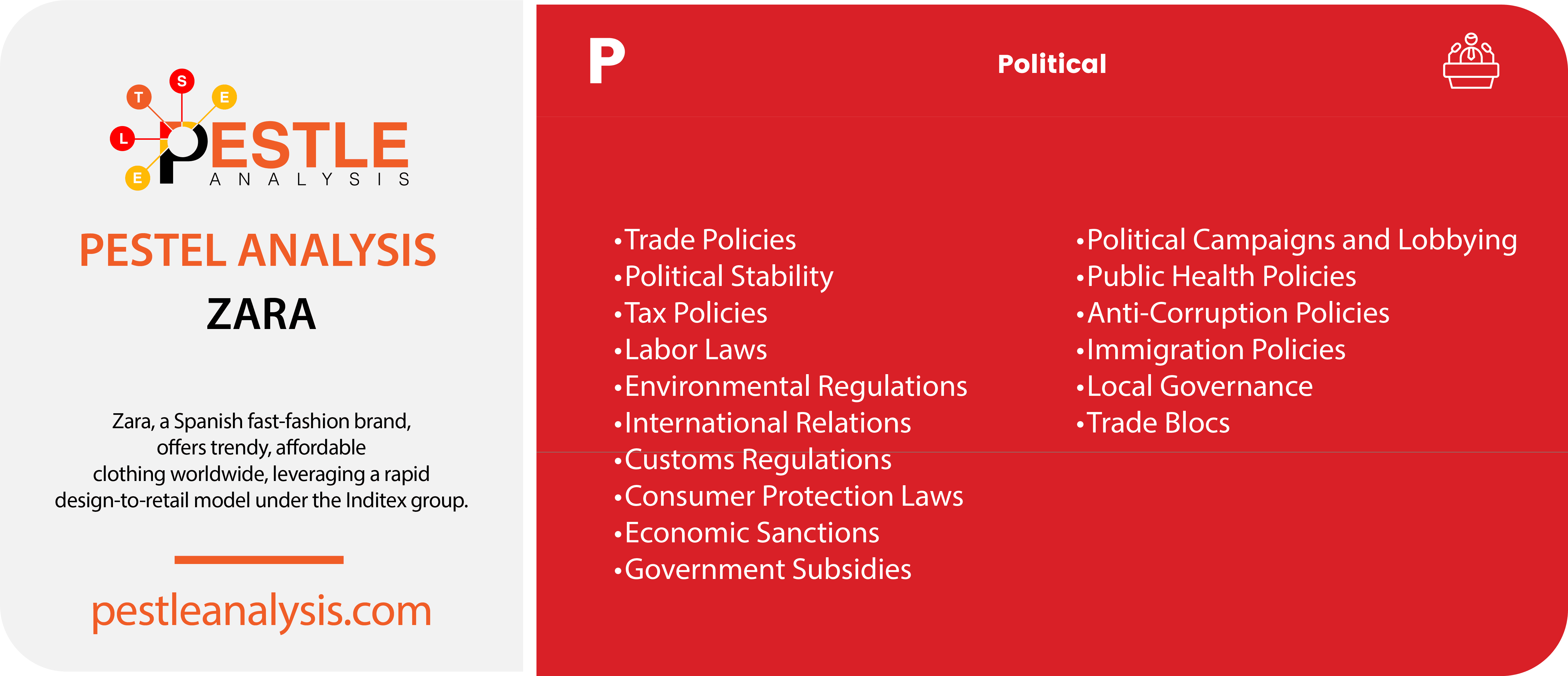
- Trade Policies: Tariffs, quotas, and trade agreements affecting the import and export of goods.
- Political Stability: The stability of governments in countries where Zara operates, influencing business confidence.
- Zara's parent company, Inditex, has announced the reopening of its stores in Ukraine after a two-year closure due to the conflict with Russia. Starting in April 2024, Inditex plans to reopen 50 out of its 80-plus stores in Ukraine, including several Zara outlets in Kyiv. This decision marks a significant step towards normalcy in war-affected areas, despite ongoing security concerns. Concurrently, Inditex has exited the Russian market, selling half of its 500 stores to the UAE's Daher Group and closing the rest, with the possibility of re-entry if conditions improve. This reflects how geopolitical instability and conflicts directly influence Zara's strategic operations and market presence in affected regions.
- Tax Policies: Corporate tax rates and tax incentives for businesses.
- Labor Laws: Regulations regarding wages, working conditions, and employee rights.
- Environmental Regulations: Government policies on sustainability and environmental protection.
- International Relations: Diplomatic relations between Spain (Zara’s home country) and other countries.
- Customs Regulations: Rules governing the import and export processes.
- In September 2020, the U.S. Customs and Border Protection issued Withhold Release Orders (WRO) on cotton and textile imports from the Xinjiang region of China due to allegations of forced labor. This move significantly affected Zara, despite Inditex's assertions of having no commercial relations with factories in Xinjiang. The ban led to protests during New York Fashion Week, with activists urging Zara to ensure their supply chain was free from forced labor.
- Consumer Protection Laws: Regulations ensuring product safety and fair marketing practices.
- Economic Sanctions: Restrictions on trade with certain countries.
- Government Subsidies: Financial aid provided to businesses in specific industries.
- Political Campaigns and Lobbying: Influence of political campaigns and lobbying on industry regulations.
- Public Health Policies: Impact of health regulations, especially seen during the COVID-19 pandemic.
- Anti-Corruption Policies: Regulations aimed at reducing corruption within business operations.
- Immigration Policies: Rules affecting the availability of labor and movement of employees.
- In 2017-2018, changes in U.S. immigration policies under the Trump administration, including stricter visa regulations and travel bans, affected Zara's operations. These policies led to labor shortages and increased difficulties in recruiting skilled foreign workers for Zara's stores and logistics centers in the United States. The company had to navigate the complexities of these immigration policies, which impacted staffing levels and operational efficiency.
- Local Governance: Influence of regional or local government policies on business operations.
- Trade Blocs: Membership in trade blocs like the EU, NAFTA, etc., impacting trade policies and regulations.
- Zara is a Spanish brand, so it enjoys all of the benefits of operating a business out of the European Union. In a political context, one of the biggest pros of running a company in the EU is the country's extensive trade agreements. Not only does this make it incredibly easy to import raw materials and export finished products within the European Union, but it also means that Zara can send its merchandise across the world with little effort and for a low cost. Overall, the EU's free-trade policies are massively beneficial for Zara; let's just hope the Union continues to thrive!
Want to understand how government policies and international trade agreements impact businesses across the globe? Dive into our detailed guide on Political Factors for all the insights you need.
Zara's Economic Factors
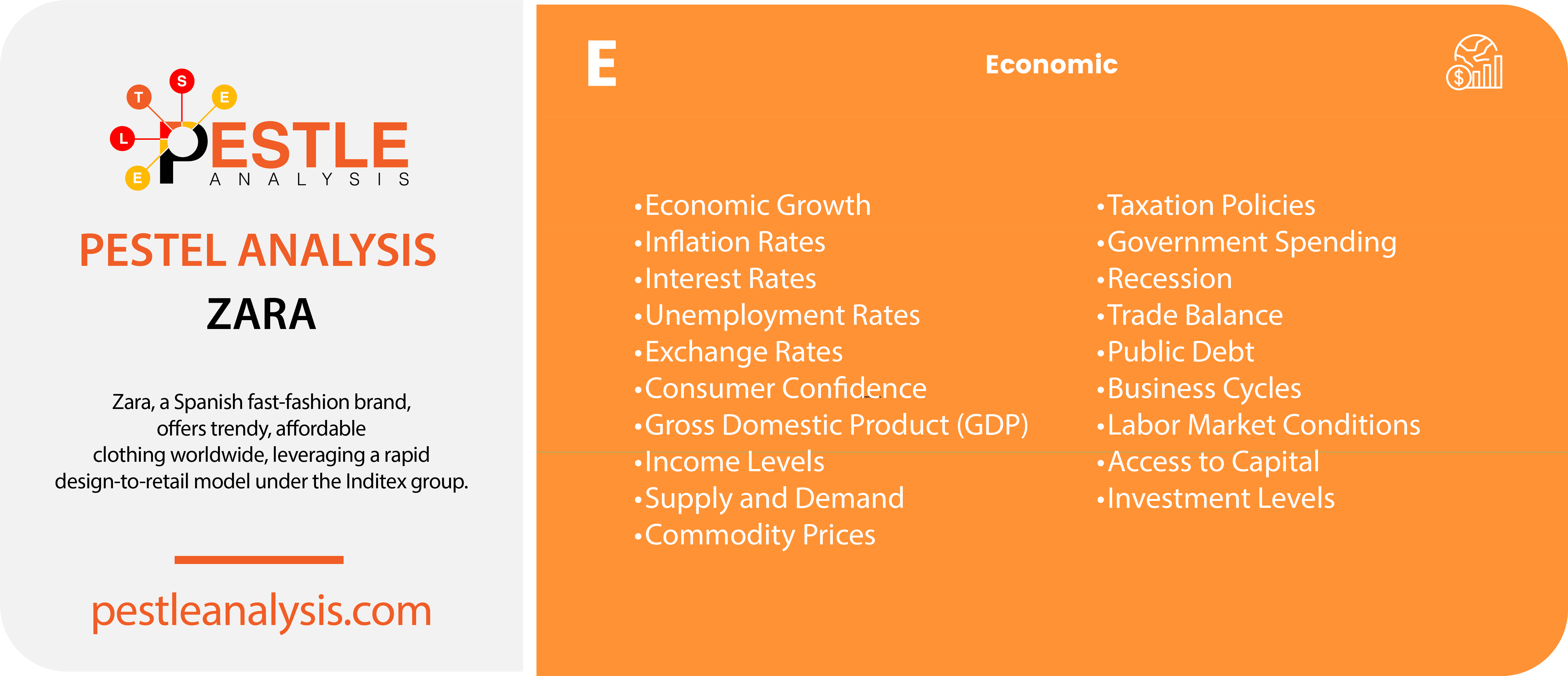
- Economic Growth: The overall growth rate of an economy, influencing consumer spending and business investment.
- Inflation Rates: The rate at which the general level of prices for goods and services is rising, affecting purchasing power.
- Interest Rates: The cost of borrowing money, influencing business expansion and consumer spending.
- Unemployment Rates: The level of joblessness in an economy, affecting consumer income and demand.
- Exchange Rates: The value of one currency relative to another, impacting international trade and profitability.
- Consumer Confidence: The degree of optimism that consumers feel about the overall state of the economy and their personal financial situation.
- Gross Domestic Product (GDP): The total value of goods and services produced within a country, indicating economic health.
- Income Levels: Average income of consumers, affecting spending power and demand for products and services.
- Zara is a well-recognized brand, so those less familiar with its products might think they're quite expensive. On the contrary, Zara is considered a relatively affordable brand in comparison to other European highstreet fashion names. This allows the company to thrive even in poorer countries; for example, despite Spain's slow economy, Zara is still one of the most popular clothing brands in the country. Indeed, Zara has some more expensive products, but what's most important is that it can cater to the majority of shoppers with the rest of its clothing lineup.
- Supply and Demand: The balance between product availability and consumer demand, influencing prices and production levels.
- Commodity Prices: Prices of essential commodities like oil, gold, and raw materials, impacting production costs and pricing.
- Taxation Policies: Corporate tax rates and other business-related taxes affecting profitability and investment decisions.
- Government Spending: Public sector spending on infrastructure, healthcare, and other areas influencing economic activity.
- Recession: A period of economic decline, characterized by reduced consumer spending and business investment.
- Trade Balance: The difference between a country’s exports and imports, affecting currency value and economic stability.
- Public Debt: The total amount of money that a government owes, influencing economic stability and future tax policies.
- Business Cycles: The fluctuations in economic activity over time, including periods of expansion and contraction.
- Labor Market Conditions: Availability and cost of labor, impacting business operations and profitability.
- As mentioned previously, Zara is a Spanish brand. Since Spain has one of the highest unemployment rates within Europe, this means that it has a relatively low cost of labor — especially in comparison to other Western European countries, such as France, Germany, and the United Kingdom. Zara manufactures a good fraction of its products in Spain, so this low labor cost allows them to minimize costs and, in doing so, improve profitability. Again, the low cost of labor in Spain is definitely a positive for this brand!
- Access to Capital: The ease with which businesses can obtain financing, affecting expansion and growth opportunities.
- Investment Levels: The amount of capital being invested in an economy, driving innovation and business expansion.
Curious about how economic trends influence various industries? Our extensive guide on Economic Factors has everything you need to know.
Zara's Social Factors
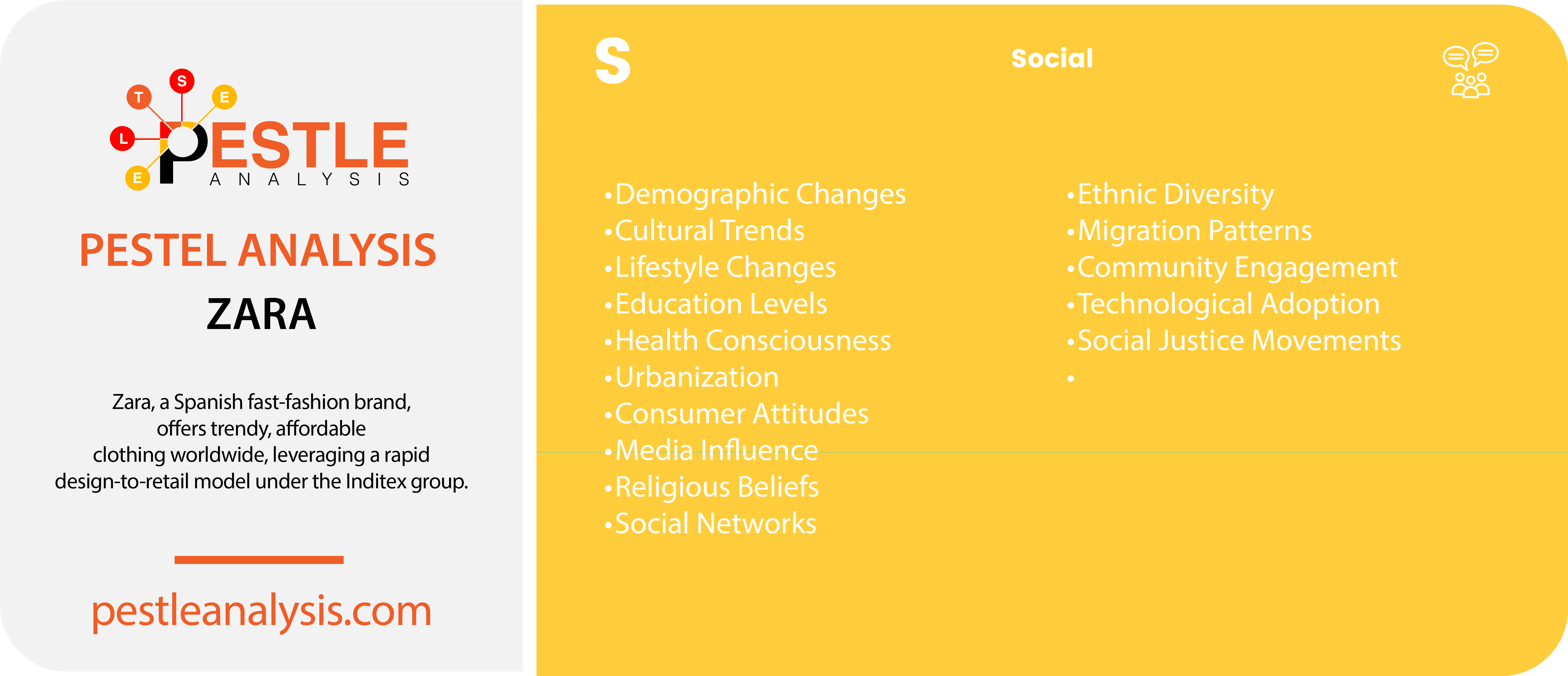
- Demographic Changes: Shifts in population characteristics such as age, gender, ethnicity, and family structure.
- Cultural Trends: Prevailing cultural norms, values, and practices that influence consumer behavior.
- Lifestyle Changes: Changes in the way people live, work, and spend their leisure time.
- Education Levels: The general level of education within a population, affecting workforce skills and consumer knowledge.
- Health Consciousness: Increasing awareness and concern for health and wellness, impacting product demand.
- Urbanization: The movement of populations from rural to urban areas, affecting market dynamics and infrastructure needs.
- Consumer Attitudes: Public opinions and attitudes towards businesses, products, and services.
- Despite its affordability, Zara is a fashionable name for most shoppers. This is where you can only praise the company for its hard work. Zara delivers a good-quality product for not a lot of money. And thanks to the brand's clever marketing efforts, it feels rather exclusive for buyers. Overall, this strong, positive brand presence allows Zara to collect healthy profit margins for its shareholders, while buyers still feel like they're getting a great deal.
- Media Influence: The impact of traditional and social media on consumer perceptions and behavior.
- Religious Beliefs: The influence of religious practices and beliefs on consumer behavior and business operations.
- Social Networks: The role of social relationships and networks in shaping consumer decisions.
- In December 2023, Zara faced a significant boycott campaign after an advertising campaign featuring mannequins with missing limbs and statues wrapped in white prompted backlash from pro-Palestine activists. Critics likened the images to corpses in white shrouds in Gaza, leading to widespread outrage on social media, with the hashtag #BoycottZara trending on X. Inditex apologized and removed the campaign, attributing the change to routine content updates.
- Ethnic Diversity: The presence and influence of various ethnic groups within a population.
- Migration Patterns: Movement of people across borders, affecting labor markets and consumer demographics.
- Community Engagement: The importance of corporate social responsibility and businesses’ involvement in local communities.
- Technological Adoption: The rate at which different social groups adopt new technologies.
- There's no doubt that online shopping is a major trend in the 21st century. Although clothes shopping might not be the best fit for the web, consumers now want to order their garments with the tap of a button, and from the comfort of their own homes. This isn't necessarily a bad thing for Zara, since they already have a popular webshop. However, Zara will have to pay close attention to the performance of its online store, since consumer's preferred channels are definitely changing.
- Social Justice Movements: The impact of movements advocating for equality, rights, and social change.
- In 2015, Zara was accused of fostering a culture of customer discrimination in its New York stores. A report by the Center for Popular Democracy, based on a survey of 251 employees, claimed that black customers were disproportionately flagged as potential thieves and labeled as "special orders," leading to increased surveillance by store staff. Zara denied the allegations, calling the report baseless and asserting its commitment to equal opportunity and diversity.
Stay ahead with the latest consumer preferences and demographic shifts affecting all businesses. Explore our in-depth guide on Social Factors.
Zara's Technological Factors
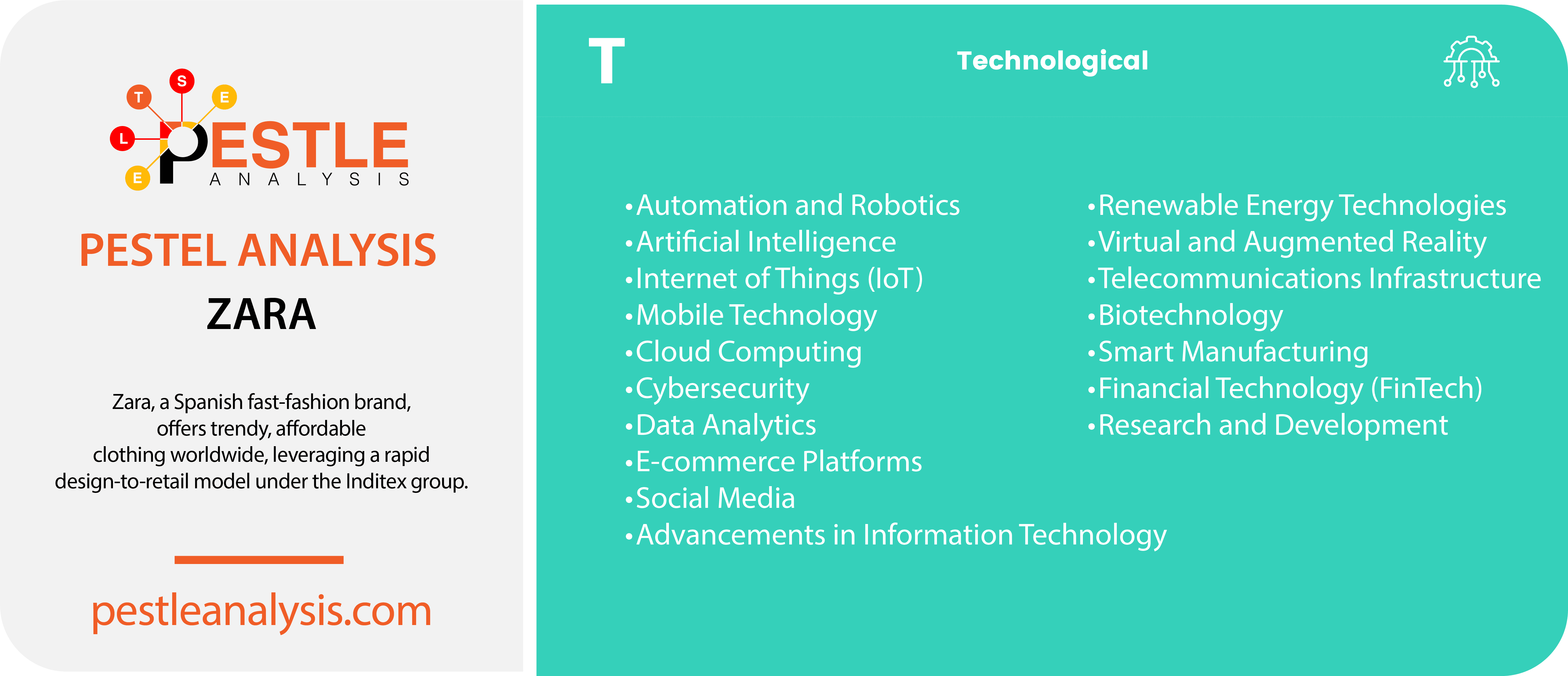
- Automation and Robotics: Increasing use of automated systems and robots in manufacturing and services.
- Artificial Intelligence: Implementation of AI for data analysis, customer service, and operational efficiency.
- Zara partnered with MIT to develop AI tools for better inventory management, demand forecasting, and personalized customer experiences.
- Internet of Things (IoT): Connectivity of devices and systems for improved monitoring and management.
- The integration of IoT in retail, as detailed by Felipe Caro, Ph.D., and Ramin Sadr, Ph.D., allows for the decoupling of information delivery and product distribution, essential for omnichannel retailing. Since 2017, Zara has leveraged Internet of Things (IoT) technology to enhance its supply chain and in-store operations. By using RFID tagging, Zara achieved near-perfect inventory tracking accuracy, which supports its strategic omnichannel objectives.
- Mobile Technology: Growth and evolution of mobile devices and applications.
- Cloud Computing: Adoption of cloud-based solutions for storage, computing power, and software access.
- In 2017, Zara's rapid success and operational efficiency were significantly bolstered by its adoption of cloud computing. This technology enabled Zara to predict fashion trends, optimize pricing, manage inventory, and enhance supply chain performance with remarkable agility.
- Cybersecurity: Measures and technologies to protect data and systems from cyber threats.
- Data Analytics: Use of big data and analytics to inform decision-making and strategy.
- Zara is one of many brands looking to use technology to expand its reach. As one of the world's most popular fashion retailers, the company has both the money and the audience needed to get the most out of data. As a result, Zara is looking to big data — the study of analyzing huge data sets — to find better ways to reach and appeal to consumers. With both online and in-person customer touchpoints, this isn't a straightforward task. But if Zara can pull off some successful data analysis, you bet they'll be able to propel their powerful business even further.
- E-commerce Platforms: Growth and sophistication of online shopping and transaction platforms.
- Social Media: Influence of social media networks on marketing, customer engagement, and brand perception.
- Advancements in Information Technology: Innovations in hardware, software, and IT services.
- Renewable Energy Technologies: Development and adoption of sustainable energy sources.
- Virtual and Augmented Reality: Use of VR and AR for immersive experiences in training, marketing, and sales.
- In 2023, Zara launched an innovative augmented reality (AR) campaign across 120 stores worldwide. This initiative allowed customers to view virtual models showcasing Zara's latest Studio collection through the Zara AR app. By pointing their smartphones at in-store displays, window displays, and AR-enabled packaging, shoppers could see international models like Lea Julian and Fran Summers posing and interacting in augmented reality. This technology not only created a unique and engaging shopping experience but also integrated seamlessly with Zara’s online and in-store purchasing systems.
- Telecommunications Infrastructure: Advances in communication networks, including 5G technology.
- Biotechnology: Innovations in biotech affecting healthcare, agriculture, and environmental management.
- Smart Manufacturing: Implementation of smart factory systems and Industry 4.0 technologies.
- Financial Technology (FinTech): Evolution of digital payment systems, cryptocurrency, and financial services.
- Research and Development: Investment in R&D for continuous innovation and competitive advantage.
Learn how cutting-edge technologies are reshaping industries worldwide. Visit our detailed guide on Technological Factors for a comprehensive understanding.
Zara's Legal Factors
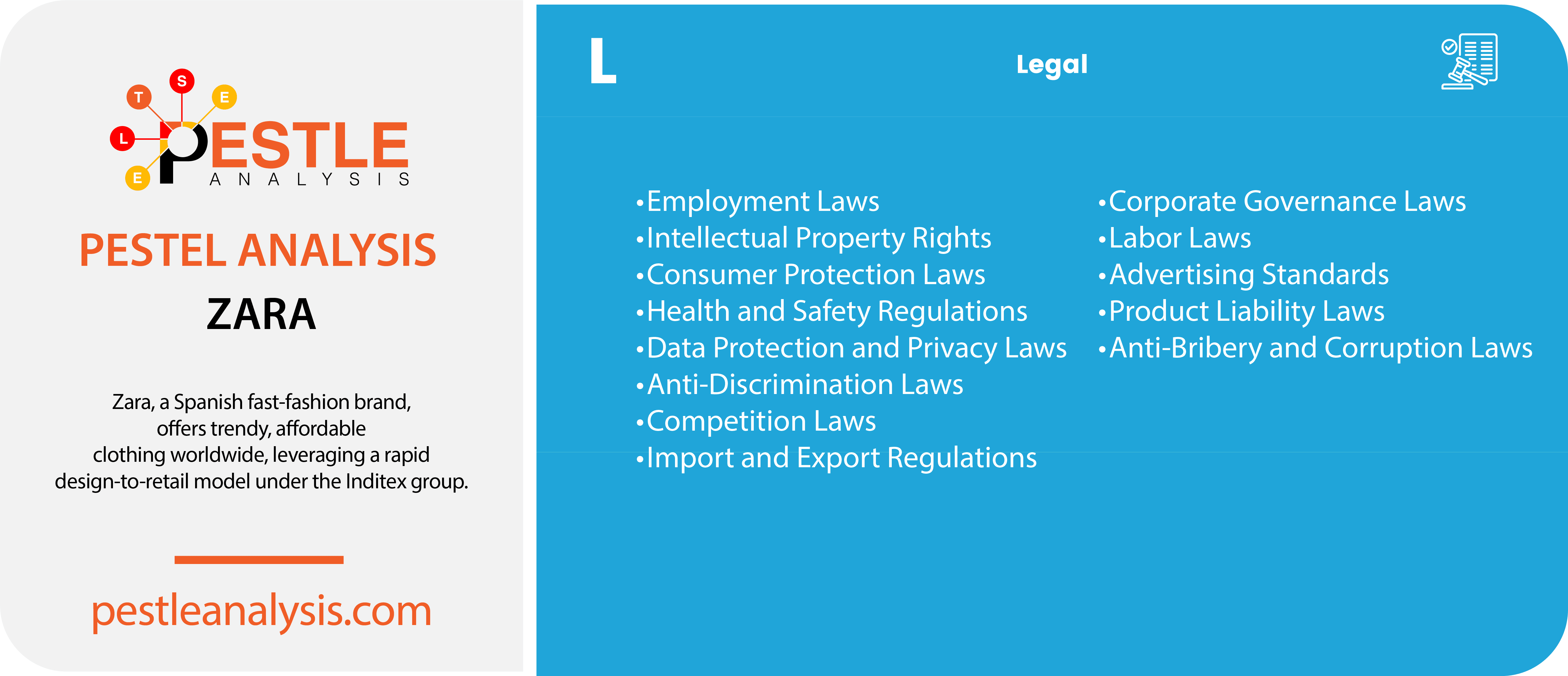
- Employment Laws: Regulations governing worker rights, wages, benefits, and workplace safety.
- Intellectual Property Rights: Laws protecting patents, trademarks, copyrights, and trade secrets.
- Like all of us, Zara has to operate within the bounds of the law. For all fashion brands, copyright law is one of the scariest legal branches out there. Since Zara loves capturing hot clothing trends and making them more affordable, it's bound to run into some issues with copyright. In fact, the major retailer already has. It's been accused of stealing designs and clothing concepts from the likes of Adidas and Balenciaga. In past cases, Zara has largely been able to weave itself out of uncomfortable legal situations like these, but who knows if the behemoth brand will continue to have such good luck.
- In April 2024, the Supreme Court confirmed that Buongiorno Myalert, S.A. had infringed Zara's trademark by using the ZARA name on a gift card offered as a prize in an advertising campaign. Consequently, Buongiorno was ordered to pay damages and publish a notice of the judgment, highlighting the importance of strict compliance with trademark laws and the protection of brand integrity.
- Consumer Protection Laws: Regulations ensuring product safety, fair trade practices, and consumer rights.
- Health and Safety Regulations: Standards to ensure workplace safety and occupational health.
- Data Protection and Privacy Laws: Regulations like GDPR governing the collection, storage, and use of personal data.
- Anti-Discrimination Laws: Legislation to prevent discrimination based on race, gender, age, disability, and other factors.
- Competition Laws: Rules to prevent monopolies and promote fair competition.
- Import and Export Regulations: Laws governing international trade, including tariffs, quotas, and customs procedures.
- Corporate Governance Laws: Regulations on the management and operation of companies, including board responsibilities and shareholder rights.
- Labor Laws: Standards for working conditions, employee rights, and dispute resolution.
- In March 2024, workers at Zara organized protests in eight major Spanish cities demanding better benefits. Spain's two largest unions, UGT and CCOO, led the protests, calling for more hours for part-time employees, a minimum number of weekends off annually, and seniority bonuses after four years of service. Despite a recent 20% wage increase for Spanish shop workers and a global 9% wage rise in 2023, union leaders argued that the company's strong financial performance justified further improvements in employee benefits.
- Advertising Standards: Regulations to ensure truthful, non-deceptive, and socially responsible advertising.
- Product Liability Laws: Standards holding companies accountable for defective products causing harm.
- Anti-Bribery and Corruption Laws: Regulations to prevent corruption and ensure ethical business practices.
Ensure compliance with laws and regulations affecting all sectors. Our extensive guide on Legal Factors will keep you informed.
Zara's Environmental Factors
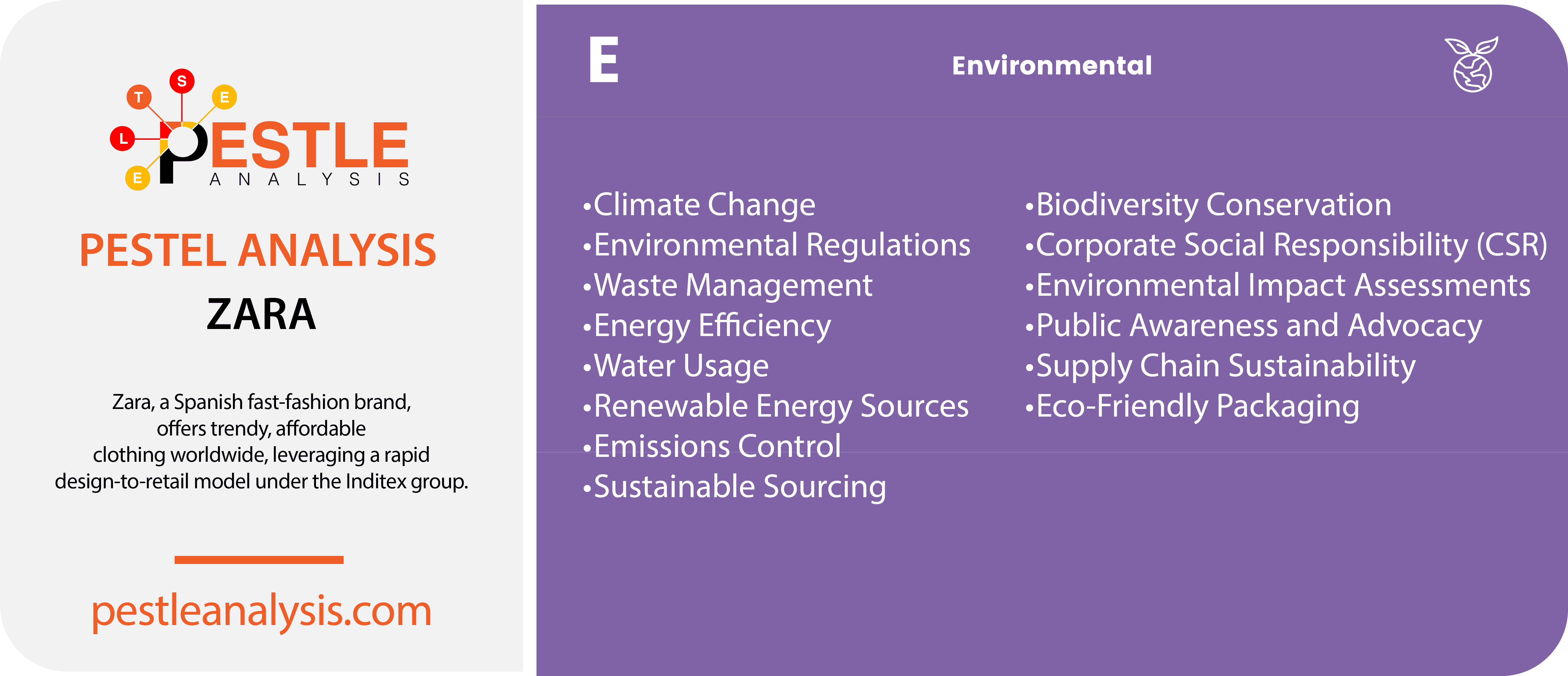
- Climate Change: Impact of global warming and changing weather patterns on operations and supply chains.
- Zara has directly experienced the impacts of climate change through severe droughts and floods in key cotton-producing regions like India and Pakistan. These events disrupted their supply chain, increased costs, and delayed product launches. Zara’s response included diversifying sourcing strategies, investing in sustainability, innovating supply chain practices, and supporting affected farmers.
- Environmental Regulations: Government policies aimed at reducing pollution and promoting sustainability.
- Waste Management: Practices and regulations for managing waste disposal and recycling.
- The world of fast fashion is often associated with wastefulness. Many fast fashion products simply aren't designed to last; instead, they're supposed to be affordable garments that look good in the changing rooms. What's more, fast fashion is said to encourage shoppers to quickly jump on trends, throwing away clothing just to stay with whatever is hot. Some might classify Zara as a fast fashion brand, so they might be accused of this wastefulness. With shoppers becoming more and more eco-conscious, this could have a negative effect on the brand if it doesn't begin to take sustainability more seriously.
- Energy Efficiency: Adoption of technologies and practices to reduce energy consumption.
- Water Usage: Management of water resources and adherence to water conservation regulations.
- In recent years, Zara faced significant challenges due to severe water scarcity in key textile dyeing regions, particularly in India and China. These areas experienced acute water shortages, affecting the availability of water for industrial use. The water scarcity led to operational disruptions in the dyeing and finishing processes of fabrics, crucial steps in Zara's production chain.
- Renewable Energy Sources: Use of solar, wind, and other renewable energy to reduce carbon footprint.
- Emissions Control: Regulations and practices to limit greenhouse gas emissions and air pollution.
- Sustainable Sourcing: Procurement of raw materials in an environmentally responsible manner.
- Biodiversity Conservation: Efforts to protect ecosystems and prevent loss of biodiversity.
- Corporate Social Responsibility (CSR): Initiatives to promote sustainable practices and social responsibility.
- To show its concern for Environmental matters, Zara's parent brand Inditex has openly published a sustainability pledge. On its website, the brand shares its "commitment" to water, climate change and energy, biodiversity, sustainable materials, animal welfare, and other environmental and ethical issues in depth. If Zara can adhere to these guidelines, we can assume it will continue to thrive even under scrutinous eyes.
- Environmental Impact Assessments: Evaluations of the environmental consequences of business activities.
- Public Awareness and Advocacy: Influence of environmental advocacy groups and public opinion on business practices.
- Supply Chain Sustainability: Ensuring that supply chain partners adhere to environmental standards.
- In April 2024, an investigative report by Earthsight linked Zara, through its parent company Inditex, to major environmental damage in Brazil's Cerrado region. The report highlighted large-scale illegal deforestation, land-grabbing, and violence associated with cotton suppliers SLC Agrícola and Grupo Horita. This cotton, used in Zara's supply chain, carried the Better Cotton label, raising concerns about the certification's traceability and efficacy. In response to increased public awareness and advocacy, Zara faced significant pressure to improve supply chain transparency and enforce stricter ethical sourcing practices, emphasizing the growing influence of consumer and advocacy group demands on corporate behavior.
- Eco-Friendly Packaging: Use of recyclable, biodegradable, or reduced packaging materials.
See how sustainability practices and environmental regulations impact businesses globally. Check out our comprehensive guide on Environmental Factors.
Recommendations Based on Zara's PESTLE Analysis
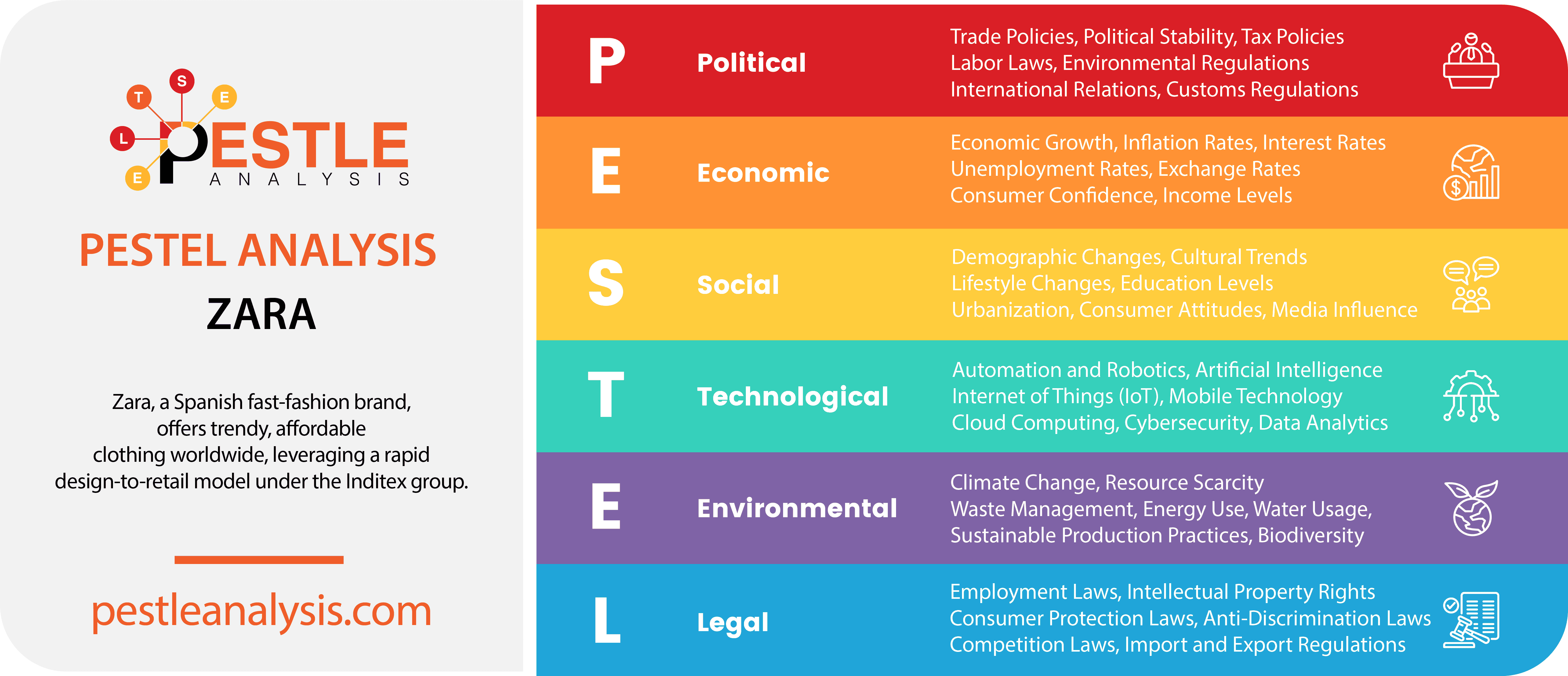
Zara is a big brand for a reason: it creates luxury-feeling fashion products at an affordable price. With lower labor costs ensuring a solid margin for shareholders, the company's core business model is solid. There are concerns about Legal and Environmental issues, but Zara should be more than mature enough to handle them!
To further deepen your understanding, I encourage you to explore more about the PESTLE analysis tool and its applications. Additionally, check out the following detailed analyses of Zara's competitors and gain comprehensive insights into the fast-fashion industry.
- PESTLE Analysis of Ralph Lauren
- PESTLE Analysis of H&M
- PESTLE Analysis of Uniqlo
- PESTLE Analysis of Gucci
- PESTLE Analysis of the fashion industry

